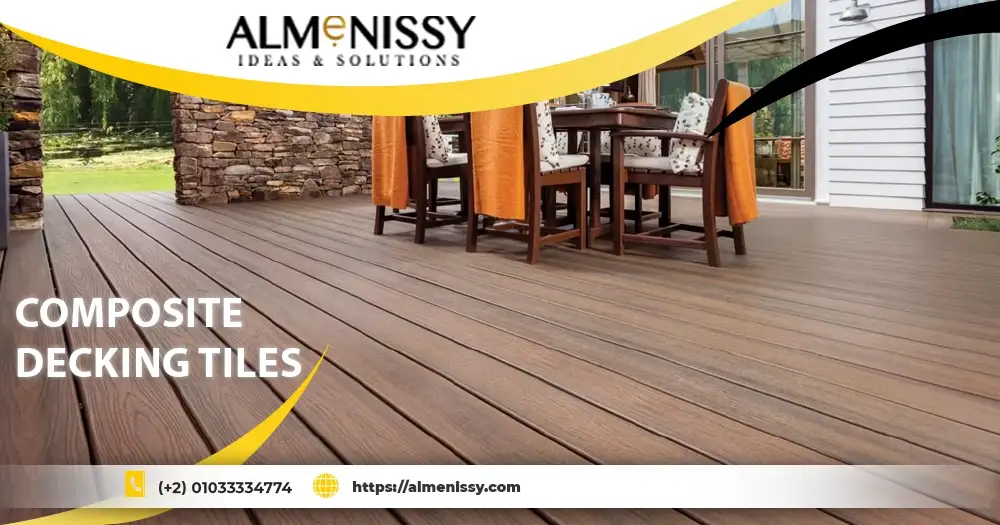Composite decking tiles represent an innovative solution in outdoor flooring, combining the aesthetic appeal of natural wood with the durability and low maintenance of modern materials. These tiles are typically made from a blend of wood fibers and synthetic polymers, resulting in a product that resists the common issues associated with traditional wood decking, such as rot, warping, and insect damage.
Composite decking tiles offer a versatile and eco-friendly option for enhancing outdoor spaces, including patios, balconies, and walkways. With their ability to mimic the look of wood while providing enhanced performance and longevity, composite decking tiles have become a popular choice for homeowners and designers seeking both style and practicality in their exterior design projects.
Table of Contents
What is a composite deck
A composite decking tiles is a type of outdoor flooring made from a blend of wood fibers and synthetic materials, typically plastics such as polyethylene or polypropylene. Composite decks are designed to resist common issues associated with traditional wood decks, such as rotting, splintering, warping, and insect damage. They are also less prone to fading from UV exposure.
Additionally, composite decking tiles often incorporate recycled materials, making them an environmentally friendly choice. They are used for various outdoor applications, including patios, decks, and walkways, providing a stylish and long-lasting solution for exterior spaces.
What are composite decking tiles made of?
Composite decking tiles are made from a combination of materials designed to provide durability and low maintenance. Typically, they consist of:
- Wood Fibers: These are often derived from sawdust or wood shavings. Wood fibers provide a natural look and feel to the composite material.
- Plastic Polymers: Commonly polyethylene, polypropylene, or polyvinyl chloride (PVC). These plastics are used to bind the wood fibers together and offer resistance to moisture, UV rays, and insects.
- Additives: Various additives may be included to enhance the material’s performance, such as colorants for aesthetics, antifungal agents to prevent mold growth, and stabilizers to improve UV resistance.
Note; This blend of materials results in a product that combines the appearance of wood with the enhanced durability and ease of maintenance provided by the synthetic components.
How to use composite decking tiles?
Using composite decking tiles involves several key steps to ensure proper installation and performance. Here’s a general guide:
1. Preparation:
- Surface: Ensure the installation surface (such as a concrete slab or existing deck) is clean, level, and dry.
- Layout: Plan the layout of the tiles to determine how they will fit and whether any cutting will be necessary.
2. Tools and Materials:
- Gather the required tools, which typically include a measuring tape, saw (for cutting tiles), spacers, and a rubber mallet.
- Ensure you have any additional materials needed for the base or underlayment if required by the specific tile design.
3. Installation:
- Starting Point: Begin installation from one corner or edge of the area, depending on the layout plan.
- Placing Tiles: Lay the tiles in the desired pattern, snapping or interlocking them together according to the manufacturer’s instructions. Many composite tiles feature interlocking systems for easy installation.
- Cutting: If necessary, cut the tiles to fit around edges or obstacles using a saw. Ensure cuts are straight and accurate for a proper fit.
4. Spacing:
- Use spacers to maintain consistent gaps between tiles, which helps with expansion and contraction due to temperature changes.
5. Securing:
- Some composite decking tiles may require securing with screws or clips, while others might lock into place without additional fasteners. Follow the manufacturer’s guidelines for securing the tiles.
6. Finishing:
- Inspect the entire installation for any gaps or irregularities. Clean the surface and remove any debris from the installation process.
7. Maintenance:
- Regularly clean the tiles with a mild detergent and water to maintain their appearance.
What are the benefits of composite decking?
Composite decking tiles offers several key benefits compared to traditional wood decking:
- Durability: Composite decking is resistant to rot, splintering, and insect damage, leading to a longer lifespan compared to wood.
- Low Maintenance: composite decking tiles requires minimal upkeep, as it does not need regular staining, sealing, or painting.
- Weather Resistance: composite decking tiles are designed to withstand harsh weather conditions, including heavy rain, UV rays, and extreme temperatures, without fading or warping.
- Aesthetic Variety: composite decking tiles come in various colors, textures, and styles, allowing for a wide range of design options that can mimic the appearance of natural wood or offer unique looks.
- Safety: The non-slip surface of composite decking provides improved safety, particularly when wet, reducing the risk of slips and falls.
- Consistency: Unlike natural wood, composite decking does not have imperfections like knots or inconsistencies, offering a uniform appearance throughout.
- Cost-Effectiveness: Although the initial cost may be higher, the reduced maintenance requirements and longer lifespan can lead to lower long-term costs compared to wood decking.
Conclusion
In conclusion, according to Almenissy company, composite decking tiles offer a compelling alternative to traditional wood decking, blending aesthetic appeal with superior durability and low maintenance. Their resistance to environmental challenges such as moisture, UV rays, and insects ensures a longer lifespan and reduced upkeep compared to natural wood.
Additionally, the eco-friendly composition of these tiles, often incorporating recycled materials, aligns with sustainable building practices.
As a result, composite decking tiles provide an attractive, practical, and environmentally responsible option for enhancing outdoor spaces. Their combination of style, performance, and sustainability makes them a valuable choice for modern exterior design and construction.
FAQ
How long do composite deck tiles last?
Composite decking tiles typically have a lifespan of 20 to 30 years, depending on factors such as the quality of the material, installation methods, and maintenance practices. Unlike traditional wood decking, composite tiles are designed to resist issues like rot, splintering, and insect damage, which contributes to their longevity. Regular cleaning and proper care can help maximize their lifespan, ensuring they maintain their appearance and performance over time.
How thick are composite deck tiles?
Composite decking tiles generally range in thickness from about 1 inch (25 mm) to 1.5 inches (38 mm). The thickness can vary depending on the manufacturer and the specific design of the tiles. Thicker tiles typically offer greater durability and support, while thinner tiles may be lighter and easier to handle. The chosen thickness should align with the intended use and the underlying support structure to ensure stability and performance.


